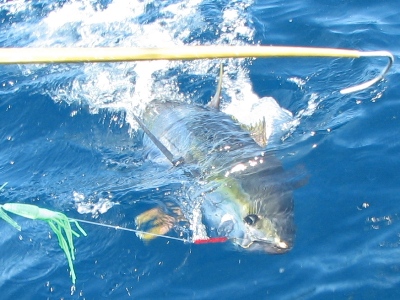In Virginia, the fall season usually brings outstanding fishing for yellowfin tuna. From 30 fathoms out to the offshore canyons, yellowfin tuna and other species are caught in good numbers.
During fall offshore fishing, trolling is usually the most common technique. Although Virginia fishermen once considered the practice of trolling ballyhoo to be essential for catching fall yellowfin, recent decades have seen trolling spreads evolve considerably.
In the last decade, one of the most popular rigs for catching yellowfin tuna is the spreader bar. Most anglers employ at least one spreader bar equipped with rainbow-colored squid or other bright colored lures.
Some tuna spreader bars are equipped with a snap on the center line, allowing anglers to change lures quickly. Some captains prefer that all lures match, while others rig a contrasting squid or other tuna lure behind the spreader bar.
Especially during the fall, anglers often report that jigging spreader bars after a strike tends to result in a higher number of hookups. When a well-season crew acts quickly, fish are sometimes hooked on several lines at once. The success of spreader bars at attracting yellowfin has contributed immensely to their popularity off the Virginia Coast.
Hurricanes and tropical storms often play a role in fall fishing. These violent weather events relocate pockets of bluewater, weedlines, debris, and pods of baitfish. In the days following a storm, the fishing often picks up considerably.
During the fall offshore fishing season, anglers seeking yellowfin tuna may also encounter a number of other pelagic fish species. Some species are smaller in size, such as the false albacore and skipjack tuna, and Atlantic bonita.
Other open ocean fish offer a much greater challenge. Among the most sought after species are bluefin tuna, longfin albacore, bigeye tuna, dolphinfish, wahoo, white marlin, blue marlin, and mako sharks.
By October, temperatures have cooled considerably and periods of fair weather become less frequent. During this time, fishing pressure is usually light and locating fish can be a challenge. Despite the challenges of late season fishing, the action can be non-stop when tuna are located.
